"CHRISTMAS" :
"DON'T OPEN
'til
DECEMBER 25th"
'Twas early morning on
Christmas ...
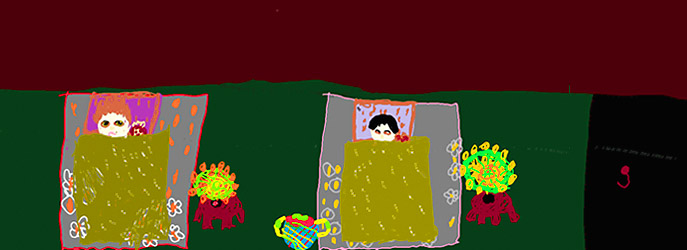
And mamma in her 'kerchief, and I in my cap
Were just
waking up from our
brief
winter's nap.
We have been anxiously listening
For Santa's last roof :
"rap-a-tap-tap".
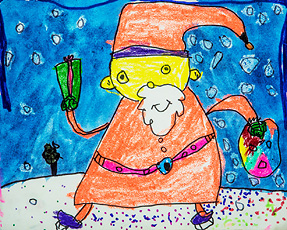
We just heard St. Nick leave, to his team give a whistle,
And fly quickly away with the speed of a missile.
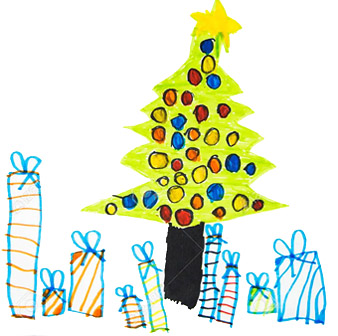
Nick's now filled all the red stockings
And emptied his pack.
We
are
ALMOST
ready
into those boxes and sacks...
But first comes a Celebration bringing sermons and
most
joyful singing !
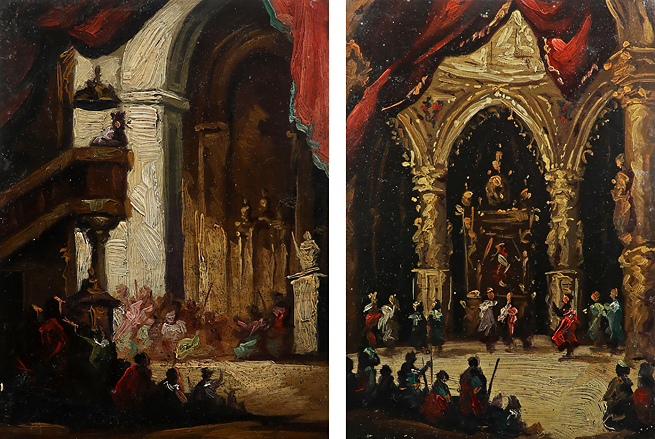
EUGENIO LUCAS Y PADILLA, SPAIN, 1824-1870
Two Miniature Cathedral Interior Paintings
(with sermons & singing),
Oil on Copper
...Once upon a time ...
long before there was a "Christmas",
with sermons or singing ... or bells a-ringing ...
people of all cultures sought hope and courage within nature.
A preeminent guardian was "The Sun":

In Roman days, the "Sun" took on a human form, known as
"SOL INVICTUS"
"Sol" was associated with Sunday, with December and the Winter "Solstice".
His special day of celebration was none other than 'December 25th'.
According to some historians, "Christmas"
was set on December 25th because of this festival.

WELL CARVED SET OF FOUR EARLY 17TH CENTURY OAK PANELS
including the above panel of "Sol Invictus", along with Diana, Mars & Jupiter
Also, a part of this Roman December festival was
"GIFT-GIVING"!
Whilst the "Gift-Giving" of Christmas
was likely patterned after
the "Three Wise Men"
... it is also connected to
three other Christmas "human personifications" :
"Father Christmas",
from the 15th century, symbolizing Christmas "gaiety",
"St. Nicholas",
bringing gifts, and whom the Dutch called "Sinterklaas"...
both figures eventually merging into the big jolly man
with his red suit, tall pointy hat, bag of gifts, and team of reindeer
"SANTA CLAUS, i.e. SAINT NICK"!
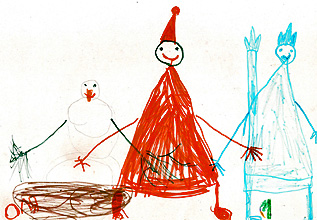
In addition to "Sinterklass", the Dutch, throughout the 17th century,
also kindly brought us (from the mysterious East)
a very precious cargo : PORCELAIN,
considered in the Western World, from c1500 to the early 1700s,
considered a most appropriate 'gift' for Nobility and Royalty -
and, it is written, even the Pope.
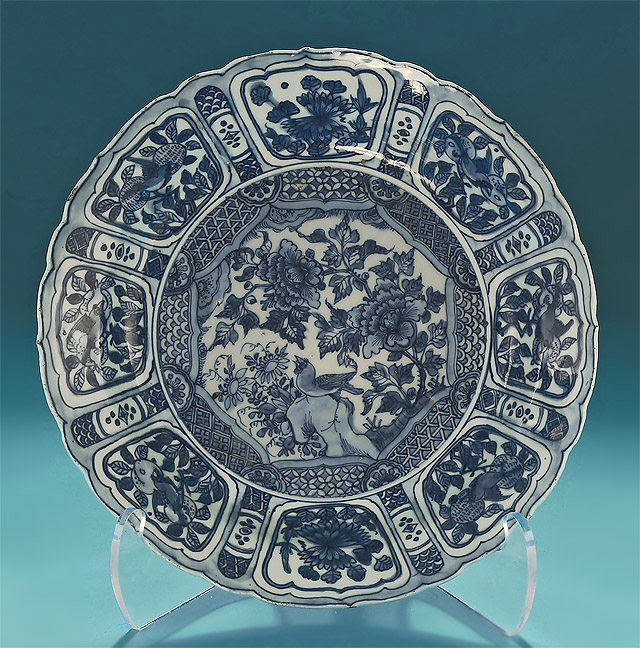
MING DYNASTY KRAAK PORCELAIN CHARGER
China, c1595-1610 'Rinaldi, Border VII.1', 12.25" Diameter
with a bird amongst floral sprays within a richly diapered cavetto, the border also with birds
See Pl. 87 for a similar example, Troesch Collection, Switzerland
To this mysterious porcelain, the
Dutch
also added their silver mounts,
for function, beauty, and our increased pleasure
(most certainly to mine,
as the combination is among my greater visual pleasures) :
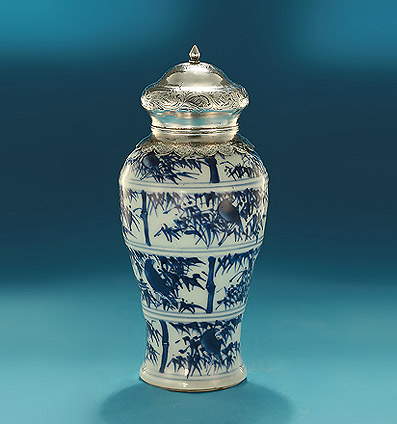
KANGXI BLUE & WHITE SILVER-MOUNTED PORCELAIN TEA CADDY
China, c1700
Dutch Silver Mounts
The Cover & Collar with 1814 Small Articles Sword
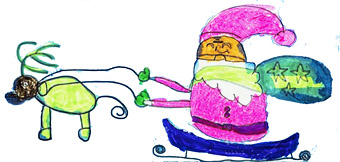
"Old
SANTECLAUS with much delight
His reindeer drives this frosty night
O'r chimney tops, and tracts of snow,
To bring his yearly gifts to you."
(Anonymous, c1821)*
This 19th century Dutch / American / British merger
'Santeclaus'
was not only miraculously
on time
(all around the world),
but always seemed to know just the right gifts
to deliver, and where!
...even to the culturally diverse regions of
the British Isles.
To the area of WALES , Santeclaus, i.e. St. Nick, would doubtless bring
"gifts of love",
or "love tokens".
Just as Christmas stockings ...
these love tokens were"hung by the fireplace with care".
The comma shapes symbolized"the soul"
, the hearts, "true love" - did declare!
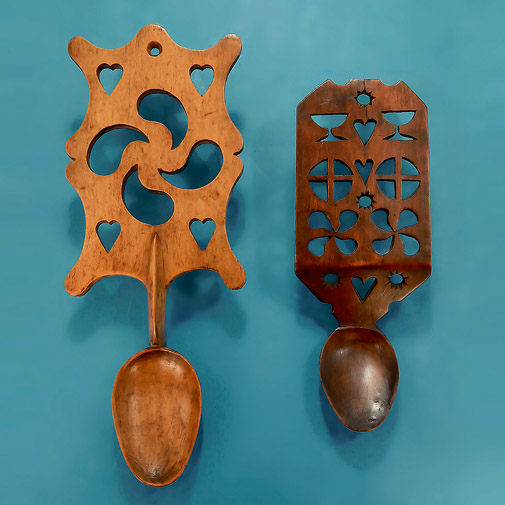
TWO 19TH CENTURY CARVED WELSH FRUITWOOD LOVE SPOONS
An endearing gift for your own true love - of any age
Left : 19th Century, with Hearts and Commas (soul, deep affection)
Right: Early 19th Century, with Hearts, Commas, Champagne Glasses,
& Wheels (lifetime support)
To neighboring
SCOTLAND,
known particularly for their love of toasts - and history,
Santa might descend chimneys with a few drinking vessels, some being 'cloaked in mystery' :
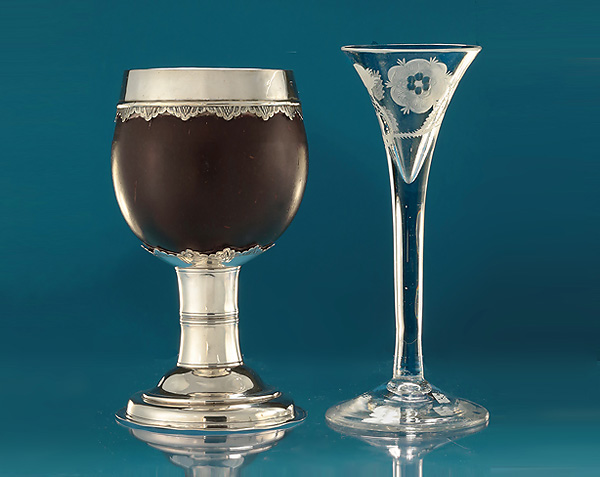
GEORGE III 'SCOTTISH PROVINCIAL' SILVER-MOUNTED COCONUT CUP
William Young, Dundee, Scotland, c1810
and a
c1750 'JACOBITE' DRAWN TRUMPET WINE GLASS
engraved with a
six-petalled Jacobite rose with convex center,
sided by an opening bud to one side and an unopened bud to the other
Santa also knows the IRISH
to be most fond! of the "come hither" of
their fine silver :
>
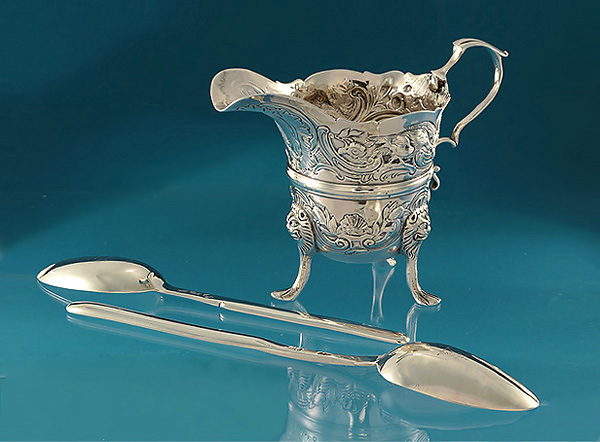
GEORGE II IRISH SILVER EMBOSSED HELMET CREAM JUG, C1750
and
TWO GEORGE II IRISH SILVER MARROW SPOONS :
Esther Forbes, Dublin, c1735,
one crested for Crosbie, Baron Brandon, later Earl of Glandore, of Ardfert, Co. Kerry,
RARE GEORGE II IRISH SILVER
"DESSERT SIZE" MARROW SPOON :
William Sutton, Dublin, c1750
Thence, on to
ENGLAND :
First, for the "Moms, Grandmothers, Aunts, even Neighbors"
who have mended our various fragments and tears
(both of 'cloth' and of 'heart')
a symbol of weaving together all that has fallen apart :

A SCARCE ELIZABETH I / JAMES I SILVER BODKIN WITH "EAR SPOON"
England, c1600-1620
Bodkins were used for centuries to lace together clothing with ribbons, and with leather cords.
"Wax from within the ear" smoothed and strengthened the threads and cords.
For finer threads, wax enabled easier threading and eliminated unwanted knotting.
Waxed thread is still a used in fine needlework today.
Then for the "Comptroller" or "Mayor of the House"
Santa might slip into a his bulging red sack,
a silver clip for keeping important papers (and
'sol'vency) intact
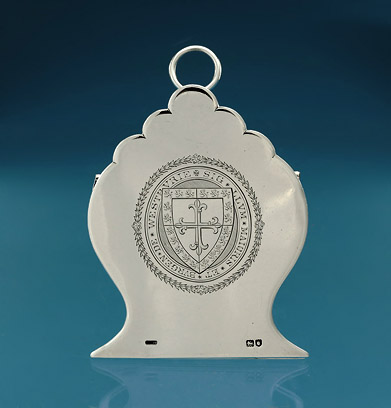
FINE EDWARDIAN SILVER LETTER CLIP, GREY & CO, LONDON 1902
bearing the arms and Seal of the Mayor Town of Westbury (Wiltshire)
"SIG LLUM MAIORIS ET BURGEN DE WESTBURIE"
And for all who collect ... for any "purpose" or "passion"...
EARLY ENGLISH SILVER BOXES
designed to meet most any whim ... or "fashion" :
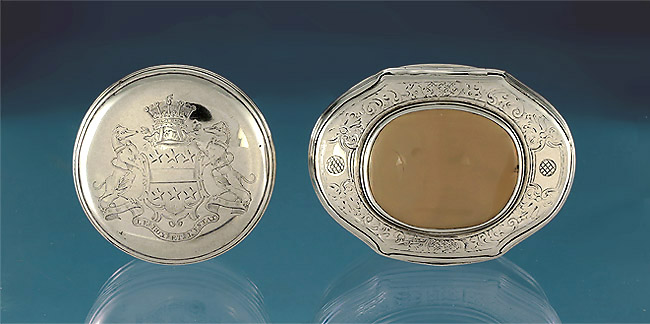
A GEORGE II ARMORIAL SILVER TOBACCO BOX
England, c1730, Bearing Arms of the Earls of Ashburnham
and
A George I / II Silver and Agate Snuff Box
England, c1720-1730
Finely engraved
For centuries, England's
'Father Christmas' celebrations were centered around
JOYOUS "TOASTING" WITH LIQUID "SPIRITS".
St. Nickolas obviously inherited oversight of these ancient traditions.
In the 17th century,
silver round-bottomed tumbler cups appeared -
ideal for toasting, quickly righting themselves,
e'er there be one too many toasts of 'good cheer' :
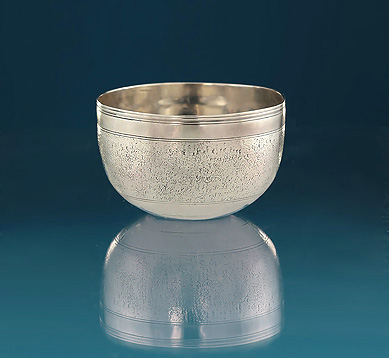
JAMES II / WILLIAM & MARY SMALL SILVER 'TUMBLER CUP'
Roger Strickland, London, c1690
with a matted ('sharkskin') surface below a plain and reeded rim
(The earliest existing silver tumbler cup dates to
1670).
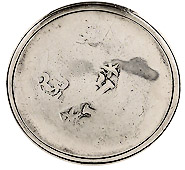
Or should toasting be on the run – or the 'ride
Santa himself might even place this by his side :
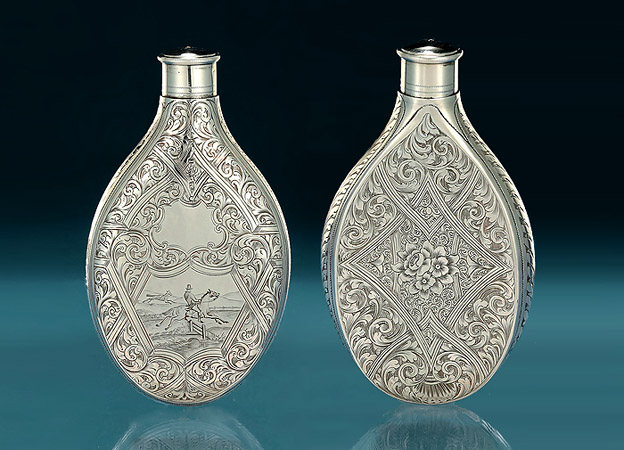
A VERY FINE VICTORIAN ENGRAVED SILVER HIP FLASK
Simeon Greenberg, Birmingham, England, 1860,
engraved with scrolling foliage and strapwork
centering a 'Hunt Scene' with horse and rider; unengraved cartouche verso
For more reserved settings, Santa's recommendation (and mine too)
is early the English drinking glass
for a noticeable enhancement of taste :
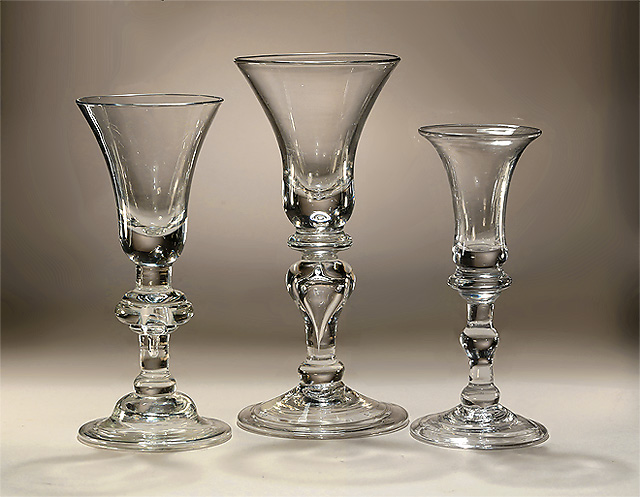
Three Early English Baluster Glasses, c1720 -30 :
Left : GEORGE I / II BALUSTER WINE GLASS, 1720-30
Middle : GEORGE I TWO-TEARED BALUSTER WINE GLASS, c1720
Right : GEORGE I / II BALUSTER CORDIAL OR GIN GLASS, C1720-30
... especially with proper decanting through a Georgian funnel,
with curved tip, and its silver resting stand :
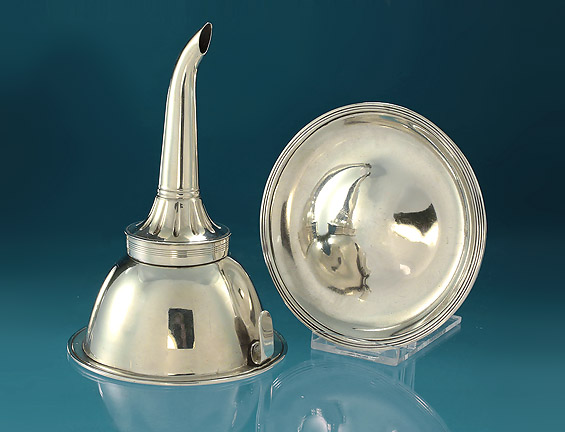
GEORGE III SILVER 3-PART REEDED WINE FUNNEL
Hennell I, David Hennell II & Samuel Hennell, London 1802,
together with a
GEORGE III SCOTTISH SILVER REEDED WINE FUNNEL STAND
Edward Livingstone of Dundee, Edinburgh, c 1800
... into the 'PERFECT'
Christmas vessel with rings of three :
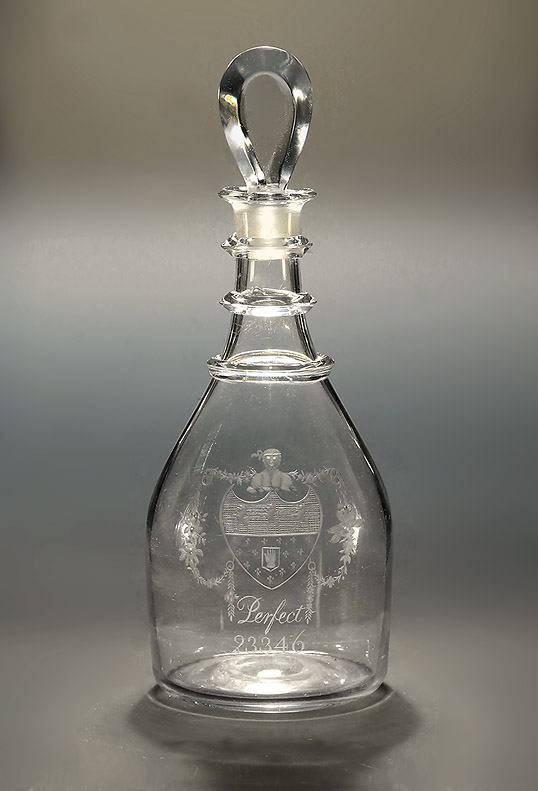
A GEORGE III ENGRAVED GLASS DECANTER
Arms of Gleane of Hardwick, Norfolk,
above the inscription
"PERFECT"...
... JUST AS WE HOPE YOUR CHRISTMAS DAY WILL BE!
And I heard him exclaim, as he flew out of sight,
"HAPPY CHRISTMAS TO ALL
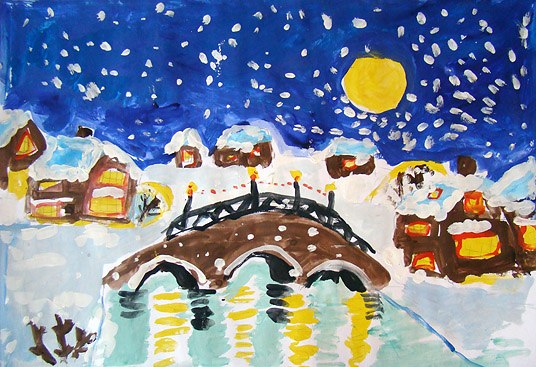
AND TO ALL A GOOD-NIGHT!"
Also See :
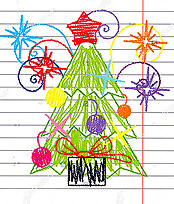
Christmas :
The Decorations
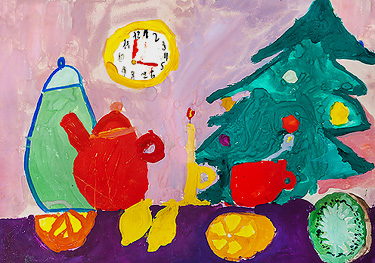
Christmas: The Do's & The Dinners
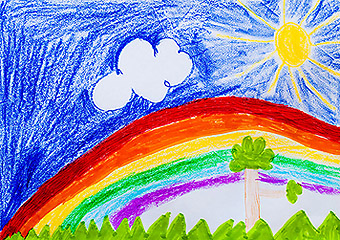
It's Christmas!
This Christmas we have featured the drawings and paintings of young children.
May their exuberance and spontaneity of expression
recall for each of us a bit of that childhood excitement we knew as
we once awaited Christmas ... and Santa's arrival on our own rooftops.
Additional Notes of Interest :
The Christmas illustrations by children, in crayon, marker, and gouache :
Creative Commons; and by lease through Shutterstock and Dreamstime
*"Old Santeclaus with Much Delight"
is an anonymous illustrated children's poem published in
"The Children's Friend"
New York,1821. It is the first publication to mention and illustrate
Santa Claus's reindeer and his sleigh, as well as being the first to describe his arrival on Christmas Eve.
As it was published in the same city as Washington Irving's earlier portrait of
Santa Claus in "Knickerbockers' History of New York",
the poem may have directly inspired another New Yorker, Clement Clarke Moore,
to create the modern Santa in "Twas the Night Before Christmas".
The
Christmas illustrations by children, in crayon, and gouache :
Creative Commons; and by lease through Dreamstime, Alamy, and 123rf
Text with a few familiar allusions to "The Night Before Christmas",
Clement Clarke Moore, Published December 23, 1823
Inventory Images : Millicent F. Creech
|